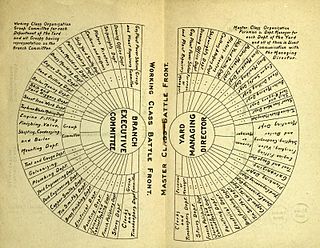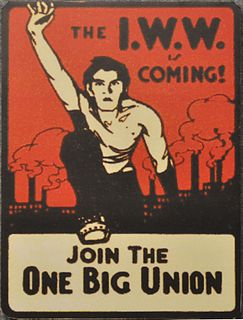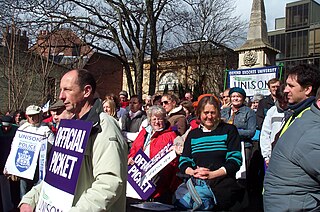Related Research Articles
A trade union, often simply referred to as a union, is an organization of workers intent on "maintaining or improving the conditions of their employment", such as attaining better wages and benefits, improving working conditions, improving safety standards, establishing complaint procedures, developing rules governing status of employees and protecting the integrity of their trade through the increased bargaining power wielded by solidarity among workers.
Industrial relations or employment relations is the multidisciplinary academic field that studies the employment relationship; that is, the complex interrelations between employers and employees, labor/trade unions, employer organizations, and the state.

Industrial unionism is a trade union organizing method through which all workers in the same industry are organized into the same union—regardless of skill or trade—thus giving workers in one industry, or in all industries, more leverage in bargaining and in strike situations.

The One Big Union was an idea in the late 19th and early 20th centuries amongst trade unionists to unite the interests of workers and offer solutions to all labour problems.
The organizing model, as the term refers to trade unions, is a broad conception of how those organizations should recruit, operate, and advance the interests of their members, though the specific functions of the model are more detailed and are discussed at length below. It typically involves many full-time organizers, who work by building up confidence and strong networks and leaders within the workforce, and by confrontational campaigns involving large numbers of union members. The organizing model is strongly linked to social movement unionism and community unionism. The organizing model contributes to the discussion of how trade unions can reverse the trend of declining membership, which they are experiencing in most industrial nations, and how they can recapture some of the political power, which the labor movement has lost over the past century.
The Australian labour movement began in the early 19th century and since the late 19th century has included industrial and political wings. Trade unions in Australia may be organised on the basis of craft unionism, general unionism, or industrial unionism. Almost all unions in Australia are affiliated with the Australian Council of Trade Unions (ACTU), many of which have undergone a significant process of amalgamations, especially in the late 1980s and early 1990s. The leadership and membership of unions hold and have at other times held a wide range of political views, including communist, socialist and right-wing views.
Amalgamated Clothing Workers of America (ACWA) was a United States labor union known for its support for "social unionism" and progressive political causes. Led by Sidney Hillman for its first thirty years, it helped found the Congress of Industrial Organizations. It merged with the Textile Workers Union of America (TWUA) in 1976 to form the Amalgamated Clothing and Textile Workers Union (ACTWU), which merged with the International Ladies' Garment Workers' Union in 1995 to create the Union of Needletrades, Industrial and Textile Employees (UNITE). UNITE merged in 2004 with the Hotel Employees and Restaurant Employees Union (HERE) in 2004 to create a new union known as UNITE HERE. After a bitter internal dispute in 2009, the majority of the UNITE side of the union, along with some of the disgruntled HERE locals left UNITE HERE, and formed a new union named Workers United, led by former UNITE president Bruce Raynor.

Trade unions in the United Kingdom were first decriminalised under the recommendation of a Royal commission in 1867, which agreed that the establishment of the organisations was to the advantage of both employers and employees. Legalised in 1871, the Trade Union Movement sought to reform socio-economic conditions for working men in British industries, and the trade unions' search for this led to the creation of a Labour Representation Committee which effectively formed the basis for today's Labour Party, which still has extensive links with the Trade Union Movement in Britain. Margaret Thatcher's governments weakened the powers of the unions in the 1980s, in particular by making it more difficult to strike legally, and some within the British trades union movement criticised Tony Blair's Labour government for not reversing some of Thatcher's changes. Most British unions are members of the TUC, the Trades Union Congress, or where appropriate, the Scottish Trades Union Congress or the Irish Congress of Trade Unions, which are the country's principal national trade union centres.
New unionism is a term used to describe moves to broaden the trade union agenda. It has been used twice in the history of the labor movement. Ben Tillett was a prominent leader of the London Dock strike of 1889. He formed the Dock, Wharf, Riverside and General Laborers' Union in 1889, which had support from skilled workers. Its 30,000 members won an advance in wages and working conditions.
Social movement unionism (SMU) is a trend of theory and practice in contemporary trade unionism. Strongly associated with the labour movements of developing countries, social movement unionism is distinct from many other models of trade unionism because it concerns itself with more than organizing workers around workplace issues, pay and terms and conditions. It engages in wider political struggles for human rights, social justice and democracy. Social movement unionism grew out of political struggles in developing countries and was theorized as a distinct industrial relations model in the late 1980s and early 1990s.

Isabel Charlotte Talbot, Baroness Talbot de Malahide, was an English philanthropist.
John Doherty (1798–1854) was an Irish trade unionist, radical and factory reformer who devoted his life to political and social reform. He was born in Buncrana in Inishowen on the north coast of County Donegal in Ireland.
The Rt Hon. Elizabeth Mary Margaret Burke-Plunkett, Countess of Fingall (1862–1944), was born in Moycullen, a daughter of George Edmond Burke of Danesfield and his wife Theresa Quin. She became an activist in Irish industrial, charitable and cultural groups, serving as second president of the Camogie Association and first president of the Irish Countrywomen's Association. She was also a noted literary hostess, whose salon at Earlsfort House was a centre of Dublin intellectual life for many years.
Alderman James McCarron was an Irish trade unionist.
The labour movement or labor movement consists of two main wings: the trade union movement or labor union movement on the one hand, and the political labour movement on the other.
The history of trade unions in the United Kingdom covers British trade union organisation, activity, ideas, politics, and impact, from the early 19th century to the present.

The National Federation of Women Workers (NFWW) was a trade union in the United Kingdom of Great Britain and Ireland active in the first part of the 20th century. Instrumental in winning women workers the right to a minimum wage for the first time, the NFWW broke down barriers for women's membership in trade unions in general.
The Irish Central Committee for the Employment of Women was an organisation set up in Ireland during the First World War as a central advisory scheme for local organisations. It operated from November 1914 until June 1919. The organisation was similar to the Central Committee on Women's Employment set up in mainland Britain.
References
- 1 2 "The Labour Year Book". The Labour Year Book. General Council of the Trade Union Congress: 367. 1919. Retrieved 9 April 2013.
- 1 2 "Historical Studies in Industrial Relations". Historical Studies in Industrial Relations. Keele University Centre for Industrial Relations (13–14): 67. 2002. Retrieved 10 April 2013.
- ↑ Moriarty, Theresa (2002). "Work, warfare and wages: Industrial controls and Irish trade unionism in the First World War". In Gregory, Adrian; Pašeta, Senia (eds.). Ireland and the Great War: 'A War to Unite Us All?'. Manchester: Manchester University Press. p. 92. ISBN 0-7190-5924-0 . Retrieved 10 April 2013.
- ↑ Moriarty, Theresa (2002). "Work, warfare and wages: Industrial controls and Irish trade unionism in the First World War". In Gregory, Adrian; Pašeta, Senia (eds.). Ireland and the Great War: 'A War to Unite Us All?'. Manchester: Manchester University Press. p. 83. ISBN 0-7190-5924-0 . Retrieved 10 April 2013.